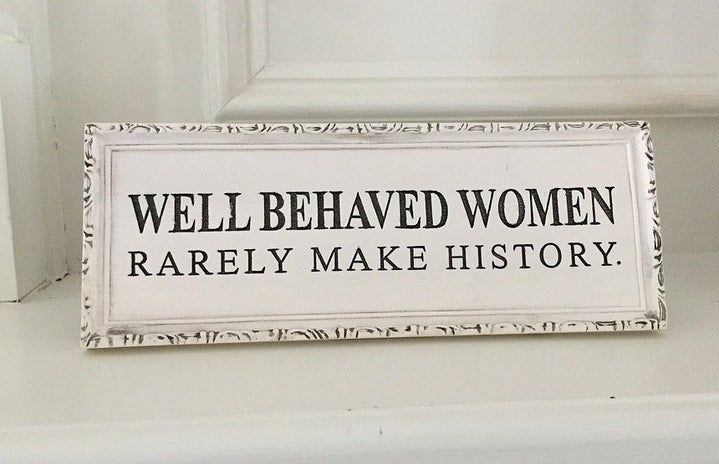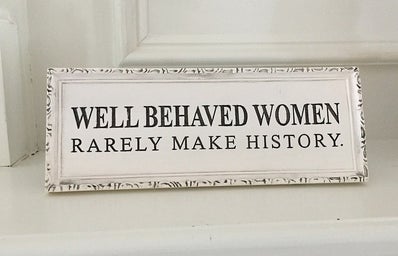The St. Petersburg Museum of History is showcasing the important women trailblazers in the city’s history with an exhibit called Meddling: The Women Who Built St. Pete. Referred by historians in St. Pete’s history books as “meddling,” they were among the pioneers, civic leaders, war heroes, and politicians that participated in male-dominated spaces and contributed to what St. Pete is today. Having showcased in June of last year, the exhibit exclusively displays historical women figures and the efforts in “stepping outside of gender norms and into male-dominated spaces.” Not only does the exhibit show the individual achievements of certain women, but it also gives insight into facts about St. Pete’s history that may have been misconstrued or not known.
The exhibit is displayed in five different sections including “Pioneers”, which spotlights Sarah Williams Armistead, known as “Mother of St. Petersburg” and the founder of the Woman’s Town Improvement Association. According to the exhibit, Armistead managed the deal between her husband John C. Williams and the Orange Bell Railroad, leading to a co-signed agreement and the eventual creation of St. Petersburg. Armistead, alongside Sarah Bethell and others, signed the 1890 replat of St. Petersburg.
“Civic Leaders” details the accomplishments of Mary Wheeler Eaton, Dr. Johnnie Ruth Clark, Mary Wyatt Allen, Margaret Acheson Stuart, the founder of the Museum Of Fine Arts, Lillian Ramsey, Olive B. McLin, Flora Wylie, Evelyn Alisman Fuller, and Phannye Ayer Ponder. Eaton was described as “bossy” and “a bit vain,” most likely due to her not only working with women but also with men, to build the city of St. Pete. Women were often described with words of negative connotations as they tried to be as involved in the city’s growth as possible. Wanting to preserve the history of the city, Eaton created the Memorial Historical Society of St. Petersburg, and later St. Petersburg Museum of History.
The “Wartime” exhibit showcases how women were instrumental to the war effort. They bought and sold war bonds, served as nurses, and worked in factories. There were also many propaganda posters displaying women to encourage others to serve as nurses in the war. During World War II, many American women wanted to assist where they could, which included being assigned to base and ship duties. So, in 1942, the Women’s Auxiliary Army Corps (WAAC) and Women Accepted for Volunteer Emergency Service (WAVES) were founded. The exhibit explains that although WAAC and WAVES were largely made up of white women, 72 Black women served in WAVES and Black women made up 5.1% of the 150,000 volunteers in WAAC. When I visited this exhibit in person, it was clear that the archivists and creators had a hard time with the lack of documents and preserved information on Black women and other people of color. The only women without a photograph in the exhibit is Anna Donaldson. Donaldson, along with her husband John Donaldson, was the first permanent Black settler in Pinellas County. Black history was and continues to not be documented as well as white history resulting in situations such as Donaldson’s where future historians lack photographs or materials. I appreciated that the creators of the exhibit utilized the information they had access to and not only showed the difference between women’s documented history compared to men’s but also the difference between Black women’s documented history compared to white women’s.
The section “Politicians” includes the women who made a change in politics by being the first elected officials, chairmen, and leaders. These specific women include Virginia Burnside, Corinne Freeman, Leslie Curran, C. Bette Wimbish, Connie Kone, and Dr. Kanika Jelks-Tomalin. Burnside was the first woman to be an elected City official in 1920 and the only woman elected until 1951. Curran is the founding member of the EDGE district association, co-founder of the First Night St. Petersburg, and a board member of the MLK Business District. Wimbish ran for School Board, but lost, when trying to fight Pinellas County Schools’ refusal to integrate. However, in 1969, she became St. Pete’s first African American City Council member and Vice Mayor in 1973. Kone served on the St. Petersburg Planning Commission, City Council, and served as Vice Mayor. She ended up saving the Museum of History by volunteering as the director while it was in financial trouble. Jelks-Tomalin made history in 2014 as a fifth-generation St Pete resident by becoming St Pete’s first African American female Deputy Mayor.
There is also a “Present Day” section that displays current female leaders and their trailblazing careers, such as Tampa Bay Business Hall of Fame’s Dr. Tonjua Williams and Alison Barlow, the Executive Director of the Innovation District. What stood out to me was the historical achievement that Corinne Freeman made in serving as St. Pete’s elected mayor. She was – and still is – the only woman to hold the mayoral office of St. Petersburg. I found the fact that she held the office for two terms to be an impressive feat. Freeman even spending 10 more years on the Pinellas County School Board after serving as mayor, shows me that she was dedicated to making as much positive change to the city as she could. You can also thank Freeman for the arrival of Major League Baseball in the city while she served aps mayor.
The exhibit also has a section “Votes For Women: The Struggle For Suffrage In Florida” that plays a video centered on the continued struggle for the right to vote for women of color, including African Americans, Native Americans, and Asians. Impactful figures during St. Petersburg’s women’s suffrage movement and ways they helped the community were displayed along with their photos. These women included Lillian Rusling, Anna Porter, and Nancy Greene Esterly, with the narrator explaining how the divide between white women and Black women was firm. Even though the 19th Amendment was passed in 1920, Black women still faced obstacles while trying to vote. Leagues in St. Pete including the Equal Suffrage League and the League of Women Voters of the St. Petersburg Area were formed around the year 1939, 19 years after the 19th Amendment. This was because, although the 19th Amendment was passed on August 18, 1920, it took Florida until May 13, 1969, to symbolically ratify the Amendment.
It is important to celebrate historical figures and events like these because many details get glossed over or completely left out especially when they involve women and people of color in history. The St. Pete Museum of History’s director, Rui Farias, commented on this problem in an interview with the St. Pete Catalyst: “Even in this building who do we talk about? Walter Fuller, Perry Snell, all those guys,” Farias said. He continued saying, “William Straub always gets credit for the downtown waterfront parks, and rightly so, but it was the Womans Town Improvement Association that took it by the throat and made sure that the parks were beautifully decorated, and that more parks were built…” Farias noted that it was archivist Jessica Breckenridge who curated and thought of the idea of the exhibit after realizing so many stories had never been told. Farias remembers Breckenridge discovering the documents that told a different version of what people thought, stating “…it was women who were signing these documents, it was women who were the majority property owners. It was women who ran these hotels.”
Having almost been displayed for a year in June, the exhibit has no end date. Breckenridge wants to explore ways to make Meddling a permanent exhibit and maybe have it moved to a larger gallery space, per her comments to the USFSP Crow’s Nest. Breckenridge also stated that people call the museum about additional historical women to put in the exhibit’s slideshow. Involving the community and being able to tell more women’s stories is an exciting part of doing the exhibit. The female-focused exhibit is the perfect way to connect to the women of St. Pete’s history this Women’s History Month. Along with the display, the museum is hosting a “Happy Hour With The Historian” on March 14. Tiffany Faykus will be speaking on the subject of “Sarah Williams Armistead: A Woman Performance” to continue celebrating women’s history in St. Pete.


